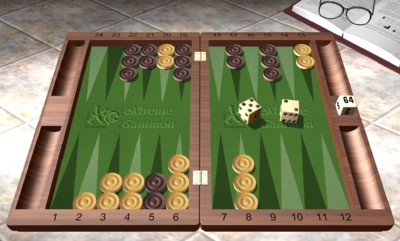This position is a fairly typical mutual holding game, a holding game where both sides have an anchor in the other player’s territory. Your first job in these games is to count the race and see where you stand. Here the pip count is 124 for White, 121 for Black. White trails by 3 pips, but after he plays his 5-2 he’ll actually lead by 4 pips.
Money game, center cube.

Black to play 5-2.
When the race is close, strategy is fairly straightforward. Bide your time, don’t do anything drastic, build up your board, and wait for something good to happen. With those simple ideas in mind, let’s look at our choices.
The horrible blunder is 20/13, making White a big underdog for no reason. Black can make his 5-point with 9 rolls and hit loose with most of the others. Even if Black rolls his worst (4-2) he’s still doing fine.
The conceptual error is 13/6. True, it’s only six shots, but why give six winning shots in an even race? The play isn’t terrible, since it has a clear upside: if Black misses, which he mostly does, White gives himself plenty of time to hold his remaining position without weakening his home board. This isn’t enough to compensate for the extra shots, but it does keep the move out of the blunder category.
Once we eliminate 20/13 and 13/6, we have to start looking at the plays that shuffle in the inner board. Jellyfish taught us how to play these positions back in the 1990s, and Snowie and Extreme Gammon have since confirmed that Jellyfish had the right concept. There are two basic ideas:
Basic idea #1: Don’t be afraid to leave blots, even multiple blots, behind your opponent’s anchor.
Basic idea #2: Arrange your spare checkers so that they can play big numbers if possible.
Many players find Idea #1 counter-intuitive and scary. “If I leave a couple of blots, aren’t I just giving my opponent an invitation to run? Shouldn’t I be locking down my board, so he has to stay?” The reason these fears are unjustified is that, for the blots to actually hurt you, a parlay of events has to happen:
(1) Black has to run.
(2) You have to hit him, in a way that doesn’t cover your blots.
(3) He has to hit you back.
Let’s say you think Black would run with half his rolls, and the other two events have about 30% probability each. In that case, the parlay of all three events happening is about 4.5% — not very likely, in other words, and nothing that should prevent you from arranging your checkers in the way that’s most likely to give you a strong board in a couple of rolls.
So what’s the best play? The right way to arrange your board is to play 8/1. This slots the ace and deuce-points, and leaves your spares back on the 6-point and the 8-point. Next turn you can cover with fours, fives, and most sixes. If the big numbers can play well, then the small numbers will be OK as well.
Notice that after a play like 8/3 6/4, White’s spares are deeper in his board, and fours and fives now play awkwardly. That’s the sort of position you want to avoid: one where your spares are misplaced and as a result you end up with an awkward, stacked position when your opponent does choose to run. Remember that the action in this position probably won’t come for another couple of turns, but when it comes, you want a strong board in place. 8/1 is the play that puts you in the best position to have that board.






